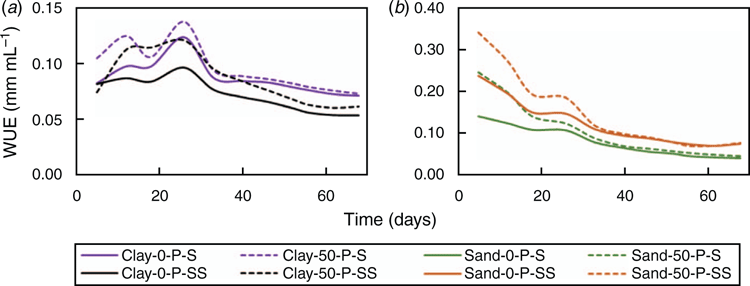Glasshouse study of a sprayable, degradable polymer to reduce water use in cotton establishment
Priscilla Johnston A D , Michael Braunack B , Philip S. Casey A , Keith L. Bristow C and Raju Adhikari A
A D , Michael Braunack B , Philip S. Casey A , Keith L. Bristow C and Raju Adhikari A
A CSIRO Manufacturing, Bayview Avenue, Clayton, Vic. 3168, Australia.
B CSIRO Agriculture and Food, Locked Bag 59, Narrabri, NSW 2390, Australia.
C CSIRO Agriculture and Food, PMB Aitkenvale, Townsville, Qld 4814, Australia.
D Corresponding author. Email: pree.johnston@csiro.au
Soil Research 58(4) 379-387 https://doi.org/10.1071/SR19306
Submitted: 23 October 2019 Accepted: 11 January 2020 Published: 18 February 2020
Journal Compilation © CSIRO 2020 Open Access CC BY
Abstract
This glasshouse pot experiment demonstrated that a new sprayable and degradable polymer reduced soil water evaporation and promoted cotton seedling emergence and establishment. The polymer was tested on two contrasting soils (sandy loam and clay), representative of those used to grow cotton in Australia. Changes in soil water content in non-treated and polymer-treated pots were monitored over 80 days, after surface or subsurface watering. Plant biomass, soil water content and soil chemical properties were determined at harvest. The polymer reduced soil water evaporation by up to 35% in sandy loam and up to 20% in clay, did not compromise seedling emergence and improved plant growth per unit water applied by up to 26.2%. The polymer underwent extensive degradation after 80 days to produce low molecular-weight polymers or oligomers and water-extractable silicon species that may have implications for plant nutrition.
Additional keywords: clay, mulch, sandy loam, sprayable polymer, water use efficiency.
Introduction
As access to water will become more variable in Australia’s cotton growing regions due to climate change (Roth et al. 2013), the economic viability of Australia’s cotton industry will increasingly rely on efficient use of scarce water resources. Numerous water management strategies have already been successfully implemented by Australian cotton growers to improve crop water use efficiency (WUE), but further significant improvements can be made through the adoption of emerging materials-based water-saving technologies (Adhikari et al. 2016, 2019).
Mulching with polyethylene or oxodegradable plastic films in furrow irrigated and rainfed cotton and other crops reduces soil water evaporation and increases cotton emergence and establishment through a combination of soil water conservation, increased soil temperatures and weed suppression (Anzalone et al. 2010; Braunack et al. 2015; Yan and Li 2016). However, specialised equipment is required to apply preformed non-biodegradable plastic mulches, so a sprayable, degradable polymer could eliminate the expense of specialised laying equipment.
There is increasing interest in the development of sprayable materials that reduce soil water evaporation and that can be applied using existing farm spray equipment. Notable spray-on materials have been derived from polysaccharides (Immirzi et al. 2009), waste leather products (Sartore et al. 2018), polysiloxanes (Al-Kalbani et al. 2003), biodegradable polycaprolactone polyurethane (Adhikari et al. 2016) and several other materials (Li et al. 2016). Typically, very high loadings of the active components of these formulations are required to achieve reductions in soil water evaporation and weed suppression.
Johnston et al. (2017) reported that a sprayable, degradable polymer barrier could be applied to soil to reduce soil water evaporation, yet still allow liquid water to infiltrate into the soil. However, it was noted that the polymer partially dislodged from the soil after surface watering, due to poor adhesion, which reduced its ability to slow soil water evaporation. They subsequently discovered that when tertiary amine segments were distributed along the polymer backbone, the polymer adhered strongly to the soil surface after watering and improved the longevity of its barrier performance against soil water evaporation. The mechanism proposed was that, below a soil pH 8.5, the tertiary amine segments increase adhesion between the polymer and the surfaces of soil particles and aggregates through hydrogen bonding or electrostatic polymer–soil interactions. This adhesion mechanism probably applies to many soil types, but would be susceptible to the influences of varying soil surface properties such as surface charge and surface group functionality.
When the polymer is in contact with soil, it is more susceptible to hydrolytic degradation at the urethane linkages and along silicon–oxygen (Si–O) bonds of the hydrophobic polydimethylsiloxane (PDMS) segments (Fig. 1). The urethane linkages in a similar polymer (without the soil anchoring segment) underwent extensive hydrolysis when incubated in water at 50°C (Johnston et al. 2016). However, when soil anchoring segments were incorporated into the polymer, the material appeared to be less susceptible to urethane hydrolysis, or slowed the rate at which it occurred. The hypothesis tested here was that the more adhesive polymer could reduce soil water evaporation while improving cotton seedling emergence and crop establishment by enhancing the infiltration and WUE. Supplementary objectives of this study were to evaluate polymer barrier performance (measured by plant growth and yield) on two different soil types to determine the effective lifetime of the material as it degraded under glasshouse conditions.

|
Materials and methods
Polymer synthesis and characterisation
A representative structure of the polymer is given in Fig. 1. It comprises three functional segments distributed randomly along the polymer backbone: a hydrophobic PDMS-derived segment, a hydrophilic polyethyleneglycol-derived segment and a soil anchoring segment derived from tertiary amine, N-methyldiethanolamine.
The synthesised polymer had an average molecular weight of Mn 59 200 g mole–1 (Mw/Mn 1.98) and was used in the glasshouse experiment as a 2.6 wt.% suspension in water (containing 0.3 wt.% sodium dodecyl sulfate as surfactant). Full experimental details for the synthesis, characterisation and formulation of the polymer are given in the Supplementary Information.
Glasshouse experiment
Design
The glasshouse experiment was run for 80 days. Sixteen treatment variables were examined, with four replicates per treatment (Table 1). The treatment codes in Table 1 specify soil type (clay or sandy loam), loading of polymer on soil (0 or 50 g m–2), planted (P) or non-planted (NP) and irrigated using a surface (S) or a subsurface (SS) watering regime.
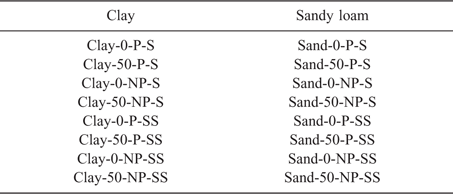
|
This particular experiment design enabled us to evaluate:
-
Polymer performance over 80 days on two types of soils after S or SS treatment, with and without the polymer treatment
-
Plant growth, yield potential and WUE in S or SS treatment pots with and without the polymer treatment
-
The effect of polymer treatment, plant growth and watering regime on soil chemical properties at harvest
-
Polymer degradation products after 80 days on soil in simulated field growth conditions.
Two additional replicate pots for each polymer treatment were sacrificially sampled at 26 and 80 days to monitor polymer molecular weight changes over the trial period.
Glasshouse details
The glasshouse experiment was conducted at the Australian Cotton Research Institute (ACRI), located at Narrabri, New South Wales (149°40′E, 30°10′S). Forced ventilation and a cooling and heating system were used to achieve set temperatures of 33°C by day and 22°C by night. The glasshouse was constructed of polycarbonate sheeting which transmitted wavelengths of 400–800 nm. The enclosure was oriented in an east–west direction, with benches positioned in a north–south direction. The glasshouse dimensions were 30.4 m (l) × 9.3 m (w) × 4.35 m (h, floor to roof apex), Only benches located along the southern half of the glasshouse were used in this experiment.
Soils
A clay textured soil with a water content of 5.2% was sieved <10 mm before use, to remove large clods. The sandy loam consisted of aggregates <10 mm and had a water content of 12.6% at the time of pot preparation. Soil chemical analyses were performed at Southern Cross University’s Environmental Analysis Laboratory (EAL), with full data given in the Supplementary Information. Key analytical data measured for the soils before the glasshouse experiment indicated that both soil types required extra nitrogen (N) to grow cotton (Table 2).
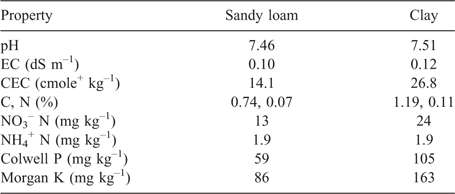
|
Pot setup
Eighty plastic pots (h. 20 cm × d. 20 cm) were half filled with the relevant soil, and a controlled release fertiliser was applied (Grow! Controlled Release Fertiliser, Bunnings: N 21.4%, P 0.5%, K 13.7%) totalling 3.2 g per pot for clay and 3.4 g per pot for sandy loam.
The pots were then filled with additional soil such that pots with clay soil contained an average of 4134 ± 228 g soil (dry weight equivalents, DWE) and pots with sandy loam soil contained an average of 3343 ± 132 g soil (DWE). Three cotton seeds (SICOT 746B3F) were planted in each pot at a depth of 2.5 cm. The diameter of the filled soil in the pots was measured and ranged within 17.8–18.7 cm corresponding to surface areas of 0.024–0.028 m2.
The aqueous polymer suspension (containing 2.6 wt% polymer) was sprayed on the soil surface of pots placed on a balance using a hand-held mist sprayer (Aqua Systems, Bunnings, see Supplementary Information), to give a final polymer loading of 50.1 ± 0.9 g m–2. The sprayed pots were left overnight to dry and generate the hydrophobic barrier layer. The control pots consisted of bare soil.
The following day, pots were placed randomly across two benches for SS treatment and two benches for S treatment (see Supplementary Information). The benches were oriented north–south. Both SS and S pots were initially placed in a saucer of water to wet the soil beneath the polymer. Wetting of the soil was stopped when the colour of the top soil darkened in control pots. This process took ~2 h for sandy loam and 4 h for clay. The pots were removed from water and allowed to drain on the bench for 5–10 min (or until dripping had ceased) and then placed in individual saucers and were individually weighed immediately to determine the mass of water taken up by the soil in each pot. The clay and sandy loam took up 359 ± 25.6 and 227 ± 13.0 g H2O kg–1 soil (DWE) respectively.
The weight of each pot was recorded again after 5 days (T5), from which the amount of water lost through evaporation, and the performance of the polymer barrier after the first subsurface watering were determined. From this point on, differential watering of the pots was undertaken weekly, as described below.
Surface watering protocol
The amount of water lost through evaporation was replaced with water applied to the soil surface. This involved placing the pot on a balance and watering (via the rose of a watering can) back to the starting wet weight (±50 g). For the polymer-treated pots, the soil was first wet with ca. 20 g of water to trigger the hydrophobic–hydrophilic transition; the remaining water was added after 30 s (which subsequently passed through the polymer-treated layer more quickly, e.g. 2–5 s).
Subsurface watering protocol
The subsurface watering was conducted by immersing the base of pots in a large dish of water to allow capillary absorption beneath the polymer treatment. The sandy loam soil absorbed water for around 2 h, while the clay soil required around 4 h. The pots were then drained for 5–10 min on the bench, before placing them back into the smaller inner saucer for weighing. The amount of water taken up was calculated from the difference between the pot dry and wet weights (±100 g from the initial wet weight).
Plant thinning
Seed coats did not slough off some of the seedlings after emergence, which reduced the survival of some plants. Attempts to soften and manually remove the seed coats by wetting the seed with a small quantity of water eliminated this problem. The plants were thinned to one per pot on day 26 (17 August 2017) by cutting the plants off at the base of the stem.
Measurements and calculations
The number of days to plant emergence was measured from the date of the first irrigation (21 July 2017).
Emergence success was calculated as the ratio of plants emerged to seeds planted, for non-treated and polymer-treated clay and sandy loam.
Plant height (from soil surface to top of stem) was monitored regularly throughout the experiment with a tape measure.
The polymer barrier performance was monitored over time in NP pots by calculating the average daily rate of soil water evaporation after each wetting–drying cycle. Daily rate of soil water evaporation was calculated from the evaporation divided by the time since last watering.
Suppression of soil water evaporation by the polymer for NP pots was calculated as a percentage reduction in total water added at time, t (i.e. control minus treated, divided by control).
The total mass of water applied to each pot was determined by weighing the pots before and after each irrigation.
The WUE was calculated by dividing plant height (mm) on a given day by the total volume (mL) of water applied up to that day.
At 80 days, the fruiting bodies (bolls) were counted on each plant, after which plants were cut off at soil level and biomass recorded. The wet biomass was then oven-dried at 70°C (2 days) and reweighed to give the dry biomass.
The top 0–10 cm of soil was collected and sent to EAL to measure the following: pH and electrical conductivity (EC, 1 : 5 water); available ammonium, nitrate and sulfur; exchangeable sodium, potassium, calcium, magnesium, hydrogen and aluminium; cation exchange capacity; Bray I and II phosphorus; and available micronutrients, including Si.
Data analysis
Unless otherwise stated, results are presented as the mean and standard deviation of measurements made for four replicates per treatment. Statistically significant differences between treatments, soil types and watering regimes on given soil types were established using one-way ANOVA and post-hoc least-squares difference (l.s.d.) tests at P ≤ 0.05. All statistical analyses were performed in Microsoft Excel using the in-built analysis ‘Toolpak’.
Results and discussion
Protection of soil water
The water-saving potential of the polymer was assessed throughout the glasshouse trial by measuring the daily rates of soil water evaporation (g day–1) occurring from the NP pots with and without polymer treatment (Fig. 2). Polymer treatment (at a loading of 50 g m–2) decreased the rate of soil water evaporation on both soil types, and under both watering regimes. This indicates the potential this polymer has to reduce irrigation requirements in contrasting soil types.
Watering regime and soil type both affected polymer performance in reducing soil water evaporation as well as the longevity of performance. With the polymer in place, soil water evaporation was initially suppressed by around 35% for sandy loam and by 20% for clay. The barrier efficacy of the polymer was better maintained throughout the length of the trial in the SS pots, whereas protection against soil water evaporation in S pots decreased over time. The ability of the polymer to reduce soil water evaporation was almost lost entirely in surface-watered clay by the end of the trial period.
The declining performance of the polymer in surface-watered pots over time is likely due to an interplay between altered polymer properties induced by degradation (Table 3) and changes in soil structure at the surface of the pots after multiple surface wetting–drying cycles (Fig. 3 and Supplementary material).

|
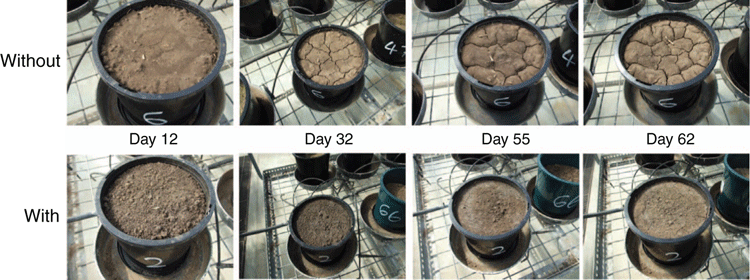
|
The gel permeation chromatography (GPC) data, collected periodically throughout this study (Table 3), revealed that residual polymer molecular weight decreased by at least 50% in the first 28 days of contact with soil. This level of degradation is likely to both reduce the barrier properties and increase water solubility of the residual polymer. Thus, the process of surface watering is more likely to have physically moved a fraction of the degraded polymer from the surface into deeper soil layers, effectively reducing the polymer concentration and barrier efficacy.
The second factor that likely contributed to loss of polymer performance in the S pots was disruption of soil surface structure of non-treated control pots after multiple wetting–drying cycles. The surface of the non-treated surface-watered clay formed large fissures and a thick crust on drying, while the surface of polymer-treated clay did not crack (Fig. 3). Surface watering of the non-treated sandy loam caused slaking, and resulted in slight cracking of the upper soil surface as it dried (from about day 32), whereas the polymer-treated sandy loam did not slake or crack (see Supplementary Information). These observations indicate the following:
-
Polymer coated soil aggregates at the top of the pot, binding them together and forming a layer that stabilised the surface soil structure
-
Pots without polymer underwent considerable changes in soil structure at the top of the pots, altering the soil water evaporation characteristics over time – particularly for clay.
Emergence, plant growth and WUE
Seedlings emerged 4–5 days after the first subsurface watering, regardless of whether the polymer was present or not. The polymer did not affect average number of days to seedling emergence in either soil type (Table 4). However, cotton seedlings emerged almost 1 day earlier from sandy loam than from clay soil (P < 0.01). At the time of planting, and due to textural, compositional and drainage effects; the sandy loam contained 12.6% water while the clay contained only 5.2%, promoting earlier germination on the sandy loam.
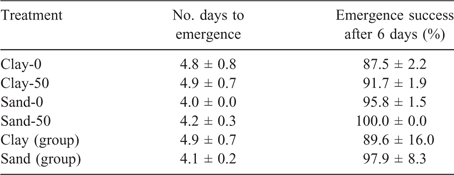
|
Emergence for non-treated and polymer-treated clay and sandy loam is shown in Table 4. Overall, the emergence success was high in both soils. However, emergence from sandy loam (95.8% for non-treated and 100% for treated) tended to be higher than from clay (87.5% for non-treated and 91.7% for treated). A crust formed on the clay during drying, which may have acted as a barrier to emergence. The emergence appeared to be marginally, but not significantly, greater when polymer was used. Field evaluation would be required to validate this finding.
At 80 days, cotton seedlings had grown significantly taller in the clay soil than in the sandy loam (Fig. 4, P < 0.05). Plants also grew marginally taller for SS versus S treatment (P < 0.05). The polymer did not significantly affect the final plant height, or the number of bolls and dry biomass (Table 5) present at harvest (P > 0.05). These findings indicate that the polymer and its degradation products did not inhibit plant growth over the first 80 days.

|
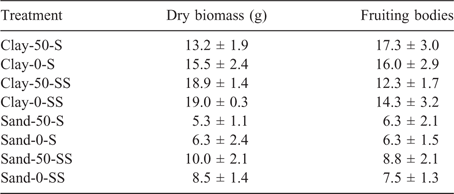
|
Although there was no increased yield in plants grown under the polymer at harvest (bolls and biomass), WUE throughout the trial showed that the polymer reduced the water requirements of the cotton plants (Fig. 5). Plants under the polymer grew 11.4–26.2% taller per unit of water applied (28 days, Fig. 5), suggesting the polymer improved plant WUE during the critical plant establishment phase. Beyond 40 days, WUE was similar for polymer treated and non-treated controls, primarily because plant growth rates levelled off, but also because polymer degradation reduced the efficacy of the barrier.
Previous studies have demonstrated that WUE of cotton plants can be increased in irrigated systems with less water than that required for maximum lint yield (Baker et al. 2015). We speculate that if irrigations were scheduled to induce moderate water stress, the polymer would conserve available water for longer, and plants grown under the polymer would produce higher yields compared to those without the polymer treatment.
Impact of the polymer on soil chemical properties at harvest
There was more nitrate (NO3–) in the 0–10 cm layer in surface-watered pots at harvest in both soil types under the polymer compared with no polymer (Fig. 6). This possibly indicates less N leaching when polymer was used. The corresponding ammonium (NH4+) data were too variable to make firm conclusions.
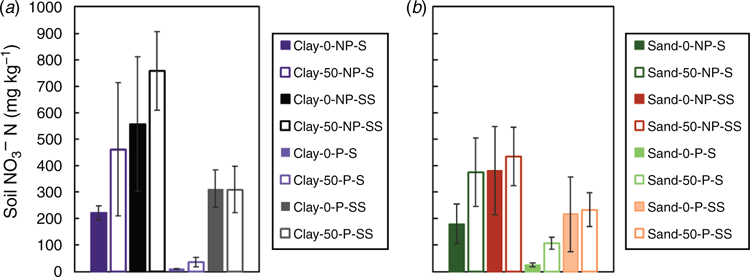
|
As expected, soil NO3– was significantly lower in the P compared with corresponding NP pots across all treatments (P < 0.01, Fig. 6). Whether NO3– uptake by cotton is greater under the polymer and whether soil microbial populations, particularly nitrifiers, change when the polymer is present is a matter for speculation. However, soil EC decreased and soil pH increased in P compared to NP pots (see Fig. 7 and Supplementary Information), suggesting a decrease in soil NO3– levels due to plant N utilisation.
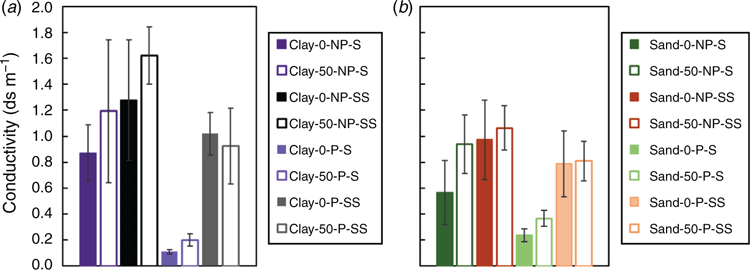
|
Polymer degradation
Surface soil was collected from representative NP polymer-treated pots at harvest. The molecular weight of the residual polymer extracted from the soil decreased from Mn 59.2 kDa at the start of the experiment to as low as 10.1 kDa after 80 days of glasshouse incubation (Table 3). This decrease in molecular weight is attributed to significant chemical degradation of the polymer during the trial. In one sense, this finding suggests that the polymer has a low soil residence time and may therefore be unlikely to contribute to problems associated with micro- and nano-plastic contamination of agricultural soils (Ng et al. 2018). Ideally, however, the polymer activity should be retained for 60–80 days to provide full water-saving benefits throughout the entire crop establishment phase and canopy closure. We speculate that use of a polymer with higher initial molecular weight could extend the effective lifetime of the barrier.
The PDMS readily hydrolyses to dimethyl silane diol (DMSD, a water-soluble Si compound) on soil, which undergoes oxidation to produce silicates and plant available silicic acid (Scheme 1) (Lehmann et al. 2002; Graiver et al. 2003). We therefore suspect that on soil in the glasshouse, the polymer is predominantly degrading by Si–O hydrolysis of PDMS segments to produce low molecular-weight polymers and oligomers (some of which can be detected by GPC) and water-soluble Si compounds.
The latter is interesting because plant uptake of water-extractable Si compounds (e.g. silicic acid, structure given in Scheme 1) from soil has been shown to provide protection to plants against abiotic stresses such as drought, salt and high temperatures (Ma 2004).
We measured the water-extractable Si in the top 0–10 cm of soil in every pot at harvest. We found that water-extractable Si tended to be higher in pots treated with the polymer, which indicates that polymer degradation leads to an increase in the amount of water-soluble Si compounds. The impact of soil pH and water content on the rate of the polymer degradation is not currently known, but may be important.
The difference in measured Si for NP and P pots showed the impact of plants on Si content in soils with and without the polymer (Fig. 8) Plants used 4–6 mg Si in non-polymer treated clay and 10–15 mg Si in non-polymer treated sandy loam. In most cases, when the polymer was in place, the Si concentration reduced to a lesser degree or increased in the case of SS sandy loam (Fig. 8). This indicates that degradation of the polymer replenishes water-soluble Si. The SS polymer-treated clay did not to follow this trend.
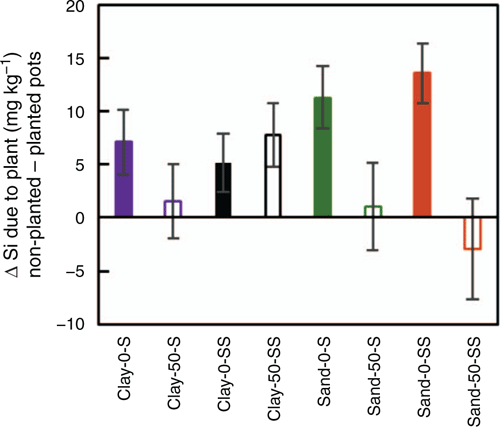
|
An interesting implication of our findings, coupled with literature evidence for the conversion of DMSD to plant available Si sources (Lehmann et al. 2002; Graiver et al. 2003), is that degradation of the polymer might actually provide plant health benefits (e.g. protection against abiotic stress factors) at later growth stages when the polymer has more fully degraded. The extent to which Si is released over time, beyond 80 days, is yet to be evaluated, but may have implications for protection against salt and heat stresses at later growth stages.
While the application rate of the experimental polymer treatment used in this study was 50 g m–2 (similar to the application rate of fertiliser such as lime or gypsum), it is 2–10 times less than other sprayable polymer systems trialled for water-saving agricultural applications (Adhikari et al. 2019). Given the polymer system is in an early stage of development, in its current form it is better considered for application in commercial production of high value crops (horticulture) where margins are greater rather than those grown on broadacre such as cotton. Potential reductions in cost may be possible by (i) using alternative and less expensive polymer precursors (e.g. less structurally complex PDMS polyol precursor, alternative polyols) either partially or completely, (ii) using cheap fillers or extenders to reduce the amount of polymer required and (iii) utilising the cost advantages of manufacturing at scale. Further trials would be required to assess these options.
Conclusions
The pot study showed that a polymer loading of 50 g m–2 reduced soil water evaporation by up to 35% for sandy loam and by 20% for clay. Suppression of soil water evaporation by the polymer declined over time but lasted longer for subsurface watering than for surface watering. Declining performance in surface-watered pots was likely due to interplay between altered polymer properties induced by degradation and changes in soil structure at the surface of the pots after multiple surface wetting–drying cycles.
The WUE showed that under the polymer, plants grew 11.4–26.2% taller per unit of water applied (at day 28). At the time of harvest, the polymer did not appear to affect final plant height, dry biomass or boll number, suggesting that the polymer and its degradation products did not inhibit plant growth during establishment.
Soil NO3– was higher in the 0–10 cm zone of S-NP pots treated with the polymer. Further work will be required to establish whether NO3– protection occurs in the field, and hence reduces the practical N requirements for cotton production.
The polymer underwent extensive degradation over the 80-day trial period to produce lower molecular-weight polymers and oligomers and water-extractable Si compounds. Further research is required to evaluate whether these water-extractable Si compounds benefit plant resistance to abiotic stresses such as drought, heat and water stress.
Conflicts of interest
The authors declare no conflicts of interest
Acknowledgements
The authors thank the Australian Department of Agriculture and Water Resources and the Cotton Research and Development Corporation for financially supporting this research through the Science and Innovation Awards for Young People in Agriculture, Fisheries and Forestry (2017). Thanks also to Heidi Clements and the breeding team at the Australian Cotton Research Institute (ACRI) for assistance and glasshouse access for the experiment.
References
Adhikari R, Bristow KL, Casey PS, Freischmidt G, Hornbuckle JW, Adhikari B (2016) Preformed and sprayable polymeric mulch film to improve agricultural water use efficiency. Agricultural Water Management 169, 1–13.| Preformed and sprayable polymeric mulch film to improve agricultural water use efficiency.Crossref | GoogleScholarGoogle Scholar |
Adhikari R, Mingtarja H, Freischmidt G, Bristow KL, Casey PS, Johnston P, Sangwan P (2019) Effect of viscosity modifiers on soil wicking and physico-mechanical properties of a polyurethane based sprayable biodegradable polymer membrane. Agricultural Water Management 222, 346–353.
| Effect of viscosity modifiers on soil wicking and physico-mechanical properties of a polyurethane based sprayable biodegradable polymer membrane.Crossref | GoogleScholarGoogle Scholar |
Al-Kalbani MS, Cookson P, Rahman HA (2003) Uses of hydrophobic siloxane polymer (Guilspare®) for soil water management. Water International 28, 217–223.
| Uses of hydrophobic siloxane polymer (Guilspare®) for soil water management.Crossref | GoogleScholarGoogle Scholar |
Anzalone A, Cirujeda A, Aibar J, Pardo G, Zaragoza C (2010) Effect of biodegradable mulch materials on weed control in processing tomatoes. Weed Technology 24, 369–377.
| Effect of biodegradable mulch materials on weed control in processing tomatoes.Crossref | GoogleScholarGoogle Scholar |
Baker J, Gitz D, Stout J, Lascano R (2015) Cotton water use efficiency under two different deficit irrigation scheduling methods. Agronomy (Basel) 5, 363–373.
| Cotton water use efficiency under two different deficit irrigation scheduling methods.Crossref | GoogleScholarGoogle Scholar |
Braunack MV, Johnston DB, Price J, Gauthier E (2015) Soil temperature and soil water potential under thin oxodegradable plastic film impact on cotton crop establishment and yield. Field Crops Research 184, 91–103.
| Soil temperature and soil water potential under thin oxodegradable plastic film impact on cotton crop establishment and yield.Crossref | GoogleScholarGoogle Scholar |
Graiver D, Farminer KW, Narayan R (2003) A review of the fate and effects of silicones in the environment. Journal of Polymers and the Environment 11, 129–136.
| A review of the fate and effects of silicones in the environment.Crossref | GoogleScholarGoogle Scholar |
Immirzi B, Santagata G, Vox G, Schettini E (2009) Preparation, characterisation and field-testing of a biodegradable sodium alginate-based spray mulch. Biosystems Engineering 102, 461–472.
| Preparation, characterisation and field-testing of a biodegradable sodium alginate-based spray mulch.Crossref | GoogleScholarGoogle Scholar |
Johnston P, Adhikari R, Bristow KL (2016) Hydrophobic-hydrophilic switchable polymers for use in agriculture. WO2017161418A1. Available at https://patents.google.com/patent/WO2017161418A1/en [verified 14 January 2020].
Johnston P, Freischmidt G, Easton CD, Greaves M, Casey PS, Bristow KL, Gunatillake PA, Adhikari R (2017) Hydrophobic-hydrophilic surface switching properties of nonchain extended poly(urethane)s for use in agriculture to minimize soil water evaporation and permit water infiltration. Journal of Applied Polymer Science 134, 44756
| Hydrophobic-hydrophilic surface switching properties of nonchain extended poly(urethane)s for use in agriculture to minimize soil water evaporation and permit water infiltration.Crossref | GoogleScholarGoogle Scholar |
Lehmann RG, Miller JR, Kozerski GE (2002) Fate of dimethylsilanediol in a grass and soil system. Applied Soil Ecology 19, 103–111.
| Fate of dimethylsilanediol in a grass and soil system.Crossref | GoogleScholarGoogle Scholar |
Li R, Hou X, Jia Z, Han Q (2016) Mulching materials improve soil properties and maize growth in the Northwestern Loess Plateau, China. Soil Research 54, 708–718.
| Mulching materials improve soil properties and maize growth in the Northwestern Loess Plateau, China.Crossref | GoogleScholarGoogle Scholar |
Ma JF (2004) Role of silicon in enhancing the resistance of plants to biotic and abiotic stresses. Soil Science and Plant Nutrition 50, 11–18.
| Role of silicon in enhancing the resistance of plants to biotic and abiotic stresses.Crossref | GoogleScholarGoogle Scholar |
Ng E-L, Huerta Lwanga E, Eldridge SM, Johnston P, Hu H-W, Geissen V, Chen D (2018) An overview of microplastic and nanoplastic pollution in agroecosystems. The Science of the Total Environment 627, 1377–1388.
| An overview of microplastic and nanoplastic pollution in agroecosystems.Crossref | GoogleScholarGoogle Scholar | 30857101PubMed |
Roth G, Harris G, Gillies M, Montgomery J, Wigginton D (2013) Water-use efficiency and productivity trends in Australian irrigated cotton: a review. Crop and Pasture Science 64, 1033–1048.
| Water-use efficiency and productivity trends in Australian irrigated cotton: a review.Crossref | GoogleScholarGoogle Scholar |
Sartore L, Schettini E, de Palma L, Brunetti G, Cocozza C, Vox G (2018) Effect of hydrolyzed protein-based mulching coatings on the soil properties and productivity in a tunnel greenhouse crop system. The Science of the Total Environment 645, 1221–1229.
| Effect of hydrolyzed protein-based mulching coatings on the soil properties and productivity in a tunnel greenhouse crop system.Crossref | GoogleScholarGoogle Scholar | 30248847PubMed |
Yan Y, Li J (2016) Cotton’s water demand and water-saving benefits under drip irrigation with plastic film mulch. Asian Agricultural Research 08, 243134
| Cotton’s water demand and water-saving benefits under drip irrigation with plastic film mulch.Crossref | GoogleScholarGoogle Scholar |



